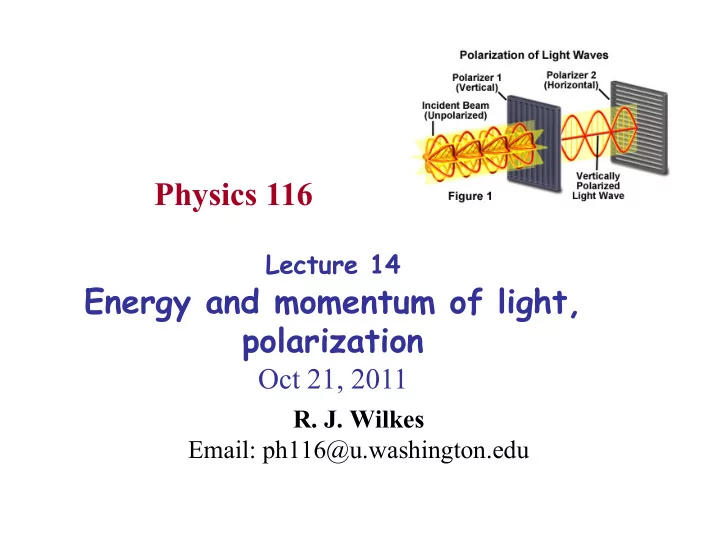

Physics 116 Lecture 14 Energy and momentum of light, polarization Oct 21, 2011 R. J. Wilkes Email: ph116@u.washington.edu
• � Guest lecturer today: Kevin Connolly
Lecture Schedule (up to exam 2) Today 3
Intensity of EM waves • � With sound waves we had intensity (watts/square meter) proportional to amplitude (pressure change) squared • � Same is true for EM waves: amplitude = N/C or teslas • � In time t, EM wave passing through a window of given area travels a distance ct meters – � All the wave energy that passed through the window lies in a volume V=(area)ct – � Energy that passed through the window is uV – � Power per square meter passing through the window is uV/t A L=ct So intensity is again proportional to A 2 , where amplitude A = E or B 4
Radiation pressure • � If a given area (window) absorbs energy U from an EM wave, it receives a transfer of momentum given by – � So we expect an illuminated surface to feel “radiation pressure” – � Unless I is huge, this is normally a microscopic value of pressure! 5
Polarization • � Wave propagating in z direction is plane polarized if the E field vector has a single orientation (in the x-y plane) • � Unpolarized light is a mixture of light waves with random E field orientations ˆ y – � x and y components are in phase � E – � Plane of “vibration” = x-y plane ˆ k � x ˆ end view
Polarized light vs natural light • � "Natural light" is unpolarized – � Waves from most sources have random polarizations • � Light bulb filament has billions of atoms, each independently emitting wavetrains – � We can filter natural light to get polarization – � Example: radio wave passing through linear array of wires • � wires short out the vertical component, only horizontally polarized wavetrains pass out in (random (horizontal mixture) component wire array only) • � Edwin Land, 1928: Polaroid filter material – � first cheap mass-market polarizing filter For light, 'wires' = aligned long organic molecules: Stretched polyvinyl alcohol (Idea from book by Brewster on kaleidoscopes)
“Analyzing” polarized light • � If light polarized in vertical plane encounters a Polaroid sheet oriented horizontally, light is blocked • � If Polaroid is at angle between 0 and 90 deg, some light gets through: E y ! � E ! � ! �
Example • � What is the angle ! if the final intensity is 10% of I 0 ? 9
Polarization by reflection • � Next week: we’ll discuss refraction of light; for now – � Index of refraction n of a material medium = c / (speed of light in that medium) – � Examples: water = 1.33, glass =1.5 ! I = angle of incidence • � David Brewster (1781-1868): ! T = angle of transmission ! I ! R n 1 Found that when ! T - ! R = 90 � ! I = angle of reflection reflected light is polarized parallel to surface 90 � (relative to normal to surface) n 2 (perpendicular to plane of incidence) Brewster (polarizing) angle: tan ! B = n 2 / n 1 ! T e.g., air/glass has ! B = tan -1 (1.5)= 57 � Reason: – � incident light has E components parallel and perpendicular to plane of incidence – � reflected light can only have component perpendicular to plane of incidence for ! R = ! T + 90 � • � Parallel component would have to be along propagation direction = longitudinal wave! Note that R=intensity reflection coefficient ~ 0.15 at ! B = 57 � So most of light intensity is transmitted – � Transmitted light is partially polarized – � Degree of polarization: – � Stack polarizer (Arago, 1812): stack of glass plates • � more layers = highter V for transmitted beam and higher I for reflected beam.
Why is the sky blue? • � Light scattered from small particles is also partially polarized • � Blue light more readily scattered by air molecules than longer " – � called Rayleigh Scattering ; strong function of wavelength – � blue light in sky has been diverted from some other path – � with some blue light missing, sun looks yellowish • � Look at setting sun through smoke: it is reddened (blue removed) 11
Today’s quiz question • � If natural light passes through a Polaroid filter, it becomes A. � Redshifted B. � Linearly polarized C. � unpolarized D. � You have to tell me more to answer 12
Recommend
More recommend